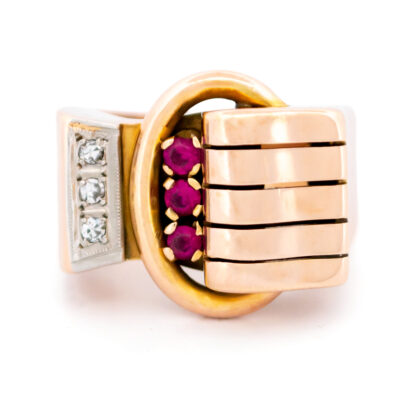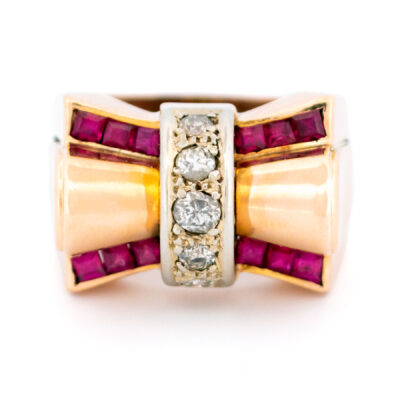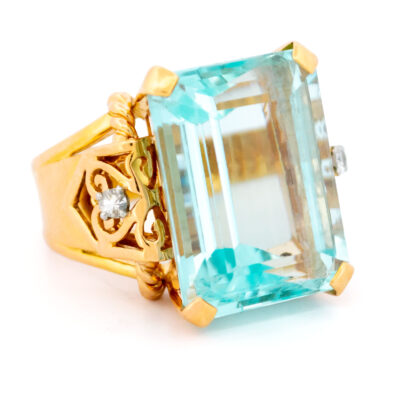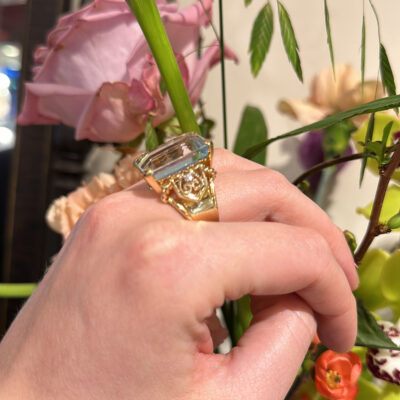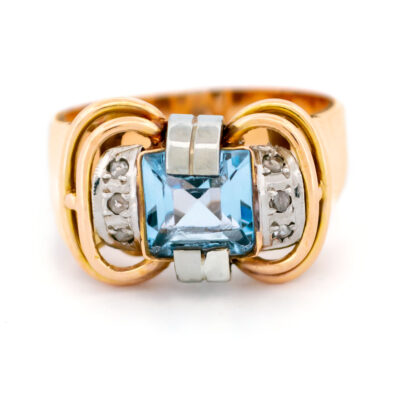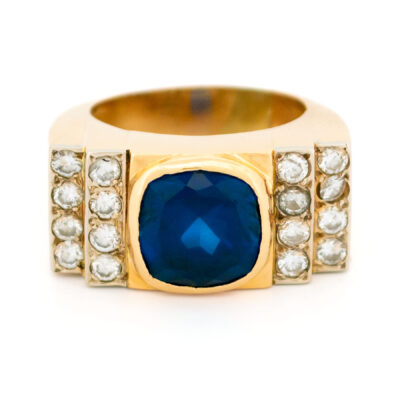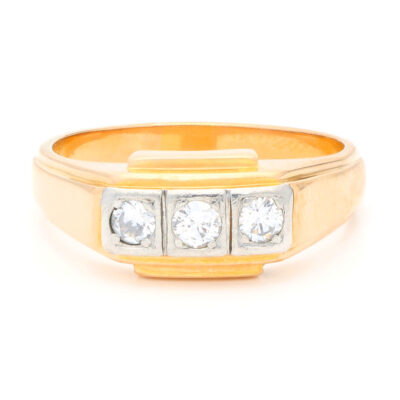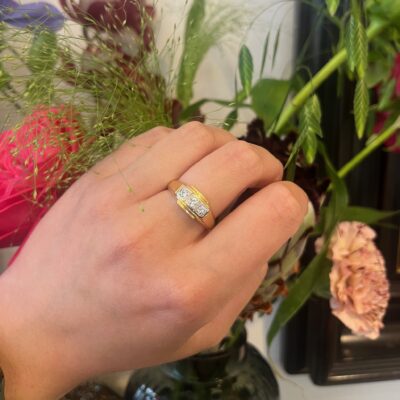A true retro gem, this 1935–1950 tank ring pairs two square green tourmalines with a crisp single-cut diamond framed in white gold. The sculpted yellow-gold ridges give it that unmistakable machine-age glamour.
Details: ±0.60ct Tourmaline, Single-cut diamond, 14k Ring.
Design Era: Retro (1935-1950).
Size: 17.25 NL / 54.5 FR / 7 US / N½ UK, sizeable (Within reason. Contact seller for information).
Weight in grams: 3.6.
Condition: Very good condition – slightly used with small signs of wear.
Shipping and Pickup: This splendid piece ships from our store located in the center of Amsterdam, The Netherlands. We offer both registered shipping and local pickup at our store. In the case of local pickup, any applicable shipping costs will be refunded.
About Us: Add some sparkle to your style with Binenbaum.com. We offer a stunning selection of antique and vintage jewelry that you won’t find anywhere else. From timeless rings and dazzling necklaces to unique brooches, we have something for every taste and occasion. Visit our website today and treat yourself to a piece of history.
| Design Era | |
|---|---|
| Design & Historical Context | The jewelry industry was significantly impacted by the onset of World War II in the 1940s. Precious metals, particularly platinum, became scarce and in some cases were even banned from being sold. Palladium was used as a substitute for platinum in the war effort. In order to make the most of the limited supply of gold, a low karat gold alloy with a higher percentage of copper was used. This resulted in gold with a subtle, reddish hue, but through the use of different alloys, gold was able to appear in a range of colors within a single piece. Gold was also manipulated in various ways, such as being woven, braided, and coiled. Techniques like resilla, cannetille, and lacy filigree patterns reappeared in jewelry. Different textures were also used within a single design, with matte finishes being placed next to bright finishes to accentuate the design. Gold became the primary metal used in jewelry during the 1940s and 1950s. |
| Key Materials | |
| Materials & Craftsmanship | Tourmaline: The Gem of Multicolor Beauty and Protection Tourmaline is a gemstone celebrated for its extraordinary range of colors, making it one of the most versatile and intriguing gems in the world. This unique stone can be found in nearly every hue, from vibrant pinks and reds to deep greens, blues, and even multicolored varieties that exhibit multiple colors within a single crystal. Historically, tourmaline has been valued for its protective and healing properties. Ancient cultures believed that tourmaline could shield its wearer from negative energies and bring balance to the mind, body, and spirit. In the 18th century, tourmaline gained popularity in Europe when Dutch traders brought it from Sri Lanka, and it quickly became a favorite among royalty and the elite. In jewelry, tourmaline is prized for its vibrant colors and versatility. With a Mohs hardness of 7 to 7.5, it is durable enough for everyday wear and can be fashioned into rings, necklaces, earrings, and more. The stone’s natural beauty is often showcased in both classic and contemporary settings, with each piece highlighting the unique coloration and brilliance of the individual tourmaline. Tourmaline is more than just a gemstone; it is a symbol of diversity, protection, and emotional balance. Its rich array of colors and deep symbolic meanings make it a captivating and meaningful choice for jewelry that stands out with elegance and character. Single-cut diamond: The Classic Sparkle of Timeless Elegance Single-cut diamonds are a classic and elegant choice in the world of fine jewelry, known for their understated yet captivating sparkle. Unlike modern brilliant-cut diamonds, which typically have 58 facets, single-cut diamonds have fewer facets—usually 17 or 18—resulting in a simpler, more traditional appearance. Historically, single-cut diamonds were among the earliest diamond cuts used in jewelry, dating back to the 14th century. This cut was popular in vintage and antique jewelry, especially during the Victorian and Edwardian eras. The fewer facets of a single-cut diamond create a subtle, soft brilliance, which adds a touch of old-world charm and sophistication to any piece. In modern jewelry, single-cut diamonds are often used as accent stones in pavé settings, vintage-inspired designs, and delicate pieces where a more refined sparkle is desired. Their simplicity makes them an excellent choice for adding a touch of elegance without overwhelming the overall design. Single-cut diamonds are more than just a gemstone choice; they are a nod to timeless beauty and classic craftsmanship. Their subtle sparkle and historical significance make them a perfect option for those who appreciate the charm of vintage and antique-inspired jewelry. 14k: The Durable Choice for Everyday Elegance 14k gold is a popular and practical choice in fine jewelry, known for its durability, affordability, and beautiful color. The "14k" signifies that the gold is composed of 58.3% pure gold and 41.7% alloyed metals, such as copper, silver, nickel, or zinc. This combination results in a strong and resilient material that can withstand the rigors of daily wear, making it an ideal option for those seeking both beauty and durability. Historically, gold has always been a symbol of wealth and luxury, and 14k gold strikes a perfect balance between the rich appearance of gold and the strength needed for everyday use. Because of its lower gold content compared to 18k or 24k gold, 14k gold is more affordable, making it a popular choice for a wide range of jewelry pieces. In modern jewelry, 14k gold is appreciated for its versatility and variety. It is available in several colors, each achieved by mixing gold with different metals: Yellow Gold: A classic and timeless choice, 14k yellow gold has a warm, golden hue that complements most skin tones and is well-suited for both modern and traditional designs. White Gold: Created by alloying gold with white metals like nickel or palladium, 14k white gold has a sleek, silver-like appearance. It is often rhodium-plated for added shine and is a popular choice for engagement rings and other contemporary jewelry. Rose Gold: Achieved by mixing gold with copper, 14k rose gold has a soft, pinkish hue that has gained popularity for its romantic and vintage appeal. It is a favorite for those seeking a unique and stylish alternative to traditional gold colors. 14k gold is commonly used in a wide array of jewelry, including rings, necklaces, bracelets, earrings, and watches. Its durability makes it especially suitable for pieces that are worn daily, such as wedding bands and engagement rings, where the balance between strength and beauty is crucial. 14k gold is more than just a practical choice; it is a symbol of enduring style and everyday luxury. Its ability to retain the look of gold while offering greater resistance to scratches and dents makes 14k gold a versatile and timeless option for any jewelry collection. Whether in a simple band or an elaborate design, 14k gold offers a perfect blend of elegance and durability that can be enjoyed for years to come. |
| Size | |
| Gender | |
| Weight (in grams) | 3.6 |
| Condition | Very good condition – slightly used with small signs of wear |
By following these tips, you can enjoy your precious jewelry for many years to come.
Related Products
-
Diamond Ruby 14k Tank Ring 17309-9165
€ 2.495,00 VAT incl. (where applicable) -
Diamond Ruby 14k Tank Ring 16232-8759
€ 2.695,00 VAT incl. (where applicable) -
Diamond 14k Tank Ring 15974-8691
€ 2.295,00 VAT incl. (where applicable) -
Aquamarine Diamond 18k Tank Ring 15858-8652
€ 5.895,00 VAT incl. (where applicable) -
Diamond Spinel 18k Tank Ring 17289-9145
€ 2.895,00 VAT incl. (where applicable) -
Diamond Verneuil Sapphire 18k Tank Ring 16163-8731
€ 4.695,00 VAT incl. (where applicable) -
Diamond 18k Trilogy Ring 17323-9173
€ 2.495,00 VAT incl. (where applicable) -
Citrine Diamond 18k Ring 16412-8843
€ 1.795,00 VAT incl. (where applicable)
- Home
- Collection
- Fine Jewelry
- Silver Jewelry
- Silverware
- Boxes
- Candlesticks
- Salt and pepper shakers
- Miniatures
- Salt cellars
- Spoon Set
- Condiments
- Frames
- Napkin Ring
- Spoon
- Oddities
- Cups
- Vases
- Cutlery
- Serving Spoon And Cake Server
- Candlesticks
- Baskets
- Hanukkiah
- Spice Tower
- Yad
- Tea Set
- Sugar Castor
- Napkin Rings
- Wine Bottle Coaster
- Wine Stopper
- Tea Pot
- Jugs
- Rattles
- Hip Flask
- Miscellaneous
- Rings 💍
- About
- Contact





